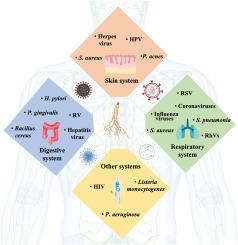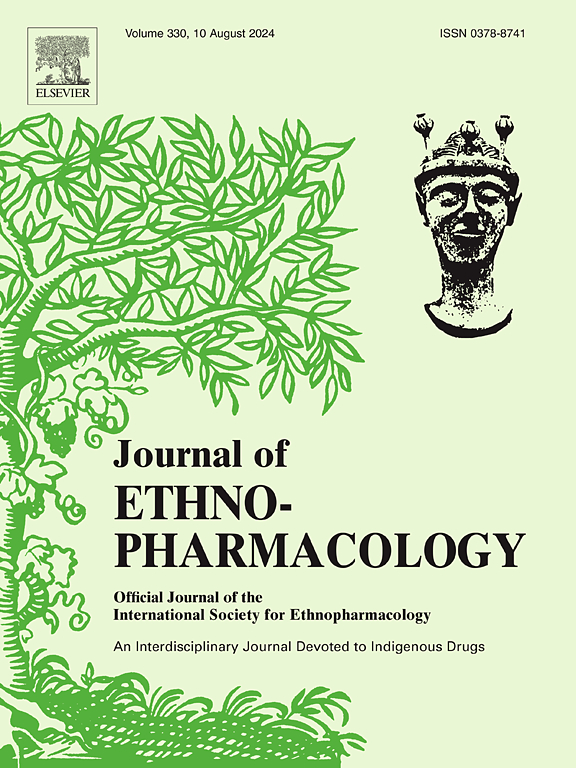Ginseng as promising natural medicine against infectious diseases: Therapeutic targets and potential mechanisms
IF 5.4
2区 医学
Q1 CHEMISTRY, MEDICINAL
引用次数: 0
Abstract
Ethnopharmacological relevance
C.A. Meyer (ginseng) has been esteemed for centuries in traditional Chinese, Korean, and indigenous medicine as a vital tonic and therapeutic agent for enhancing resilience and treating infectious diseases. Historically, used for respiratory or skin infections, gastrointestinal disorders, etc. These applications align with modern evidence supporting its broad-spectrum anti-infective activity. Ginsenosides, the principal bioactive constituents, have been shown to exert targeted effects against diverse infectious pathogens. This review integrates ethnomedical insights with contemporary pharmacology, highlighting ginseng's translational potential in combating antimicrobial resistance and emerging infectious diseases.
Aim of the study
This review aims to elucidate the therapeutic targets and molecular mechanisms of ginsenosides’ anti-infective activities and critically evaluates their translational potential in addressing emerging infectious diseases and antimicrobial resistance.
Materials and methods
A comprehensive literature search was conducted across PubMed, Web of Science, ScienceDirect, SpringerLink, Elsevier, and the Chinese National Knowledge Infrastructure (CNKI) using keywords such as “ginsenosides”, “anti-infective”, “antiviral”, “antibacterial”, and “immunomodulation”. Relevant studies published in English and Chinese were systematically screened, extracted, and analyzed to elucidate the mechanisms and clinical potential of ginsenosides in combating infectious diseases.
Results
Ginsenosides exhibit anti-infective effects through three major mechanisms: (i) direct inhibition of viral entry and replication; (ii) immunomodulatory activity via activation of macrophages, T cells, and dendritic cells; and (iii) suppression of pro-inflammatory pathways, particularly NF-κB and MAPK signaling. They also demonstrate synergistic effects with conventional therapies against key pathogens such as influenza virus and SARS-CoV-2. Additional benefits include modulation of the gut microbiota and enhancement of host immune responses, underscoring their multifaceted therapeutic profile.
Conclusion
Ginsenosides represent promising natural anti-infective agents with broad-spectrum activity. This review highlights their mechanistic basis and clinical potential, supporting their development as novel therapeutics in the fight against infectious diseases, including the urgent threat of antimicrobial resistance.

人参作为抗感染性疾病的天然药物:治疗靶点和潜在机制。
民族药理学相关性:几个世纪以来,人参在中国、朝鲜和本土医学中一直被视为一种重要的补品和治疗剂,可以增强韧性和治疗传染病。历来用于呼吸道或皮肤感染、胃肠道疾病等。这些应用与支持其广谱抗感染活性的现代证据相一致。人参皂苷是主要的生物活性成分,已被证明对多种感染性病原体具有靶向作用。这篇综述将民族医学见解与当代药理学结合起来,强调人参在对抗抗菌素耐药性和新出现的传染病方面的转化潜力。研究目的:本文旨在阐明人参皂苷抗感染活性的治疗靶点和分子机制,并批判性地评价其在解决新发传染病和抗微生物药物耐药性方面的转化潜力。材料和方法:在PubMed、Web of Science、ScienceDirect、SpringerLink、Elsevier和中国知网(CNKI)上进行全面的文献检索,检索关键词为“人参皂苷”、“抗感染”、“抗病毒”、“抗菌”和“免疫调节”。系统筛选、提取、分析相关中英文文献,阐明人参皂苷抗感染性疾病的作用机制及临床潜力。结果:人参皂苷通过三种主要机制发挥抗感染作用:(1)直接抑制病毒的侵入和复制;(ii)通过激活巨噬细胞、T细胞和树突状细胞的免疫调节活性;(iii)抑制促炎通路,特别是NF-κB和MAPK信号。它们还显示出与流感病毒和SARS-CoV-2等关键病原体的常规疗法的协同效应。其他益处包括调节肠道微生物群和增强宿主免疫反应,强调其多方面的治疗概况。结论:人参皂苷是一种具有广谱活性的天然抗感染药物。这篇综述强调了它们的机制基础和临床潜力,支持它们作为对抗传染病的新疗法的发展,包括抗微生物药物耐药性的紧迫威胁。
本文章由计算机程序翻译,如有差异,请以英文原文为准。
求助全文
约1分钟内获得全文
求助全文
来源期刊

Journal of ethnopharmacology
医学-全科医学与补充医学
CiteScore
10.30
自引率
5.60%
发文量
967
审稿时长
77 days
期刊介绍:
The Journal of Ethnopharmacology is dedicated to the exchange of information and understandings about people''s use of plants, fungi, animals, microorganisms and minerals and their biological and pharmacological effects based on the principles established through international conventions. Early people confronted with illness and disease, discovered a wealth of useful therapeutic agents in the plant and animal kingdoms. The empirical knowledge of these medicinal substances and their toxic potential was passed on by oral tradition and sometimes recorded in herbals and other texts on materia medica. Many valuable drugs of today (e.g., atropine, ephedrine, tubocurarine, digoxin, reserpine) came into use through the study of indigenous remedies. Chemists continue to use plant-derived drugs (e.g., morphine, taxol, physostigmine, quinidine, emetine) as prototypes in their attempts to develop more effective and less toxic medicinals.
 求助内容:
求助内容: 应助结果提醒方式:
应助结果提醒方式:


